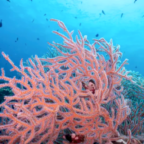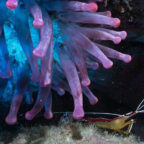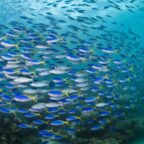
In the field of marine conservation, a marine protected area (MPA) is an expanse of sea, ocean, estuaries, coastal waters, and in the United States, the U.S. Great Lakes, where fishing, mining, drilling, and other extractive human activity is restricted in an effort to protect the waters’ natural resources and marine life.
Deep-sea corals, for example, which can be up to 4,000 years old, can be damaged by fishing trawls that drag along the ocean floor, scooping up bottom-dwelling fish and crustaceans. By not allowing humans to deplete, disturb, or pollute waterways at will, MPAs discourage such damage to and disregard for sea life. But while MPAs provide a framework for us to sustainably interact with Earth’s waters, weak enforcement of their rules and regulations means they’re not always as effective as they aim to be.
The Evolution of Marine Protected Areas
:max_bytes(150000):strip_icc()/Raui_marine_protected_area_sign_Rarotonga_Island_Cook_Islands-99437d2efcc94ebfacb73066c5defbda.jpg)
The idea of restricting access to marine areas as a way to revitalize them has existed for centuries. The Indigenous Peoples of the Cook Islands, for example, practice the “ra’ui” system, a tradition enacted by the Koutu Nui (traditional leaders) which temporarily prohibits fishing and foraging whenever a food source is in low supply.
Modern-day MPAs, however, evolved over a period of decades from the 1960s onward, as myriad global conferences and conventions increased awareness of threats to our oceans. Some of the events that helped propel global MPAs forward include the 1962 First World Conference on National Parks, which explored the idea of creating marine parks and reserves to defend marine areas from human interference; and the International Union of Conservation of Nature’s (IUCN’s) 1973 critical marine habitats project, which developed criteria for selecting and managing MPA sites. Also helping to shape global MPAs was the 1982 United Nations (UN) Convention on the Law of the Sea—a collection of treaties and international agreements, which established that nations “have the sovereign right to exploit their natural resources,” but that they should do so “in accordance with their duty to protect and serve the marine environment.”
Meanwhile, the Marine Protection, Research, and Sanctuaries Act of 1972, which prohibited ocean dumping, was largely responsible for kicking-off the MPA movement in the United States. That same year, the U.S. Congress established a MPA program managed by the National Oceanic and Atmospheric Administration (NOAA).
Today, more than 15,000 MPAs cover roughly 7% of the world’s marine environment. Nearly 1,000 of that number are in the United States.
Are Marine Protected Areas Effective?
MPAs provide a multitude of conservation and climate benefits, including improving water quality, protecting species during spawning periods, and promoting greater biodiversity (variation of marine flora and fauna). A study in Science Magazine found that coral reefs that face less fishing pressure and that are located away from human populations see the greatest chance at recovery, whereas those facing intense human impacts rebound more slowly.
The potential benefits of MPAs are so bountiful that in 2004, and again in 2010, the United Nations (UN) Convention on Biological Diversity set a target of converting 10% of the world’s marine areas into MPAs by 2020. While nations missed this international target, about 8.5% of oceans, or an area the size of North America, is now covered by MPAs, according to the Marine Conservation Institute’s marine protection atlas. Zoom in on the United States, and that number increases to 26%, says the National Oceanic and Atmospheric Administration (NOAA).
However, recent research suggests that the aerial coverage of MPAs may not be as important to marine safeguarding as two other factors: the type of MPA—”no-take” or partially-protected—that is implemented, and how closely an MPA site’s rules and regulations are followed.
“No-Take” Marine Reserves Offer the Greatest Benefits
No-take MPAs, which are also known as “marine reserves,” ban all activities that remove or harm marine life, whereas partially-protected MPAs allow some degree of human activity, such as fishing, boating, swimming, snorkeling, kayaking, or more, within its borders.
Because of this, some scientists, including social ecologist John Turnbull and his colleagues at the University of New South Wales in Australia, say partially-protected MPAs merely “create an illusion of protection.” Conservationist and National Geographic Explorer-in-Residence, Enric Sala, also recognizes the benefit of no-take over partially-protected MPAs. According to his analysis published in the ICES Journal of Marine Science, fish biomass (the weight of the used to interpret health) in marine reserves is over three times greater than that in partially-protected MPAs.
Only 3% of global ocean areas and 3% of U.S. waters are in highly protected no-take zones.
Stricter Regulation and Enforcement Is Needed
Of course, even if no-take MPAs are in place, there’s no guarantee that people will abide by their rules and regulations. Despite the fact that MPA zones and boundaries are mapped by NOAA, and are physically marked with buoys and signs, many are located in remote parts of the world, and aren’t routinely policed, meaning the honor code system is largely in effect.
:max_bytes(150000):strip_icc()/33845617721_cd9581a99c_k-0cd9343476494ccb9d1d48128dc64120.jpg)
Sadly, visitors don’t always act in a trustworthy manner when no one is looking. In the Florida Keys National Marine Sanctuary, for example, mooring buoys are installed so that visitors, who are allowed to boat, fish, and dive in the partially-protected MPA, may do so without damaging the reef with boat anchors. (Mooring buoys give boats a place to tie up to, and thereby avoid the need to drop anchor.) However, over 500 vessel groundings, on average, occur within the sanctuary every year.
Such violations occur within international MPAs, too. A 2020 study conducted by Oceana, a nonprofit organization which works to influence policy decisions to preserve and restore the world’s oceans, revealed that 96% of the nearly 3,500 European MPAs surveyed, including the Natura 2000 MPAs, allowed at least one extractive or industrial activity, or infrastructural development (such as an oil/gas rig) within their boundaries. Oceana also found that 53% of MPA sites reported no active management. And where management plans did exist, 80% of those plans were incomplete or failed to address major threats affecting the sites.
One remedy to the problem of ineffective MPA management is stricter oversight. Perhaps as the global community works toward the international goal of protecting 30% of the world’s oceans by 2030, it can also take the opportunity to improve the effectiveness of MPAs by adopting innovative surveillance tools, such as drones, satellite-tracking systems for vessels, and passive acoustics systems which use sound to detect when a vessel is nearby, into its MPA management plans.















Social Profiles